In a world of digital enticements, India’s museums showcase enduring material creativity. They may inspire renewed artistry in modern generations.
By Anuradha Goyal
A museum is a glimpse into a time and space that we are not a part of, an opportunity to interact with the past through what has been left behind for us. It is a time travel of its kind. Museum comes from the root word muse and traces its roots to 16th century Florence, where it referred to collections of curious objects. Museums as we know them now were first established in Oxford in the late 1700s. In India, the first one came up in 1814 at Calcutta, and it was simply called the Indian Museum. This continues to be one of the best-loved museums in the country, holding some of the finest collections, including Buddhist stupas and railings from Bharhut.
Today museums are popping up everywhere, showcasing the grandeur of the past, history of technological evolution, human stories and micro-histories of all possible subjects. Sometimes they go all-out and create dioramas and virtual cities to showcase the living traditions. Allow me to take you on a tour to some of the museums that showcase the nation as it was, as it evolved and as it stands today.
National Museum, New Delhi
The National Museum, located close to metro stations in the heart of Lutyens, Delhi, is one of my favorites. It is home to the National Museum Institute, which offers courses in art appreciation and museology. It has some of the finest galleries and exquisite artifacts. For example, the Harappa gallery has the famous dancing girl from Harappa, the Buddhist gallery holds relics of Buddha, making it a place of pilgrimage for Buddhists, and the Chola gallery has some of India’s best bronzes. The only museum that can match this Chola collection is the Government Museum at Egmore, Chennai, where you can see a documentary on the making of such bronzes using the ancient lost wax method.

My top recommendation here is the gallery of miniature paintings from across the country—from Pahadi in the hills to Deccan in the South, and all possible schools of Rajputana in between. These paintings illustrate epics like Ramayana and Mahabharata, seasons, musical ragas, sports and festivals, all celebrating life and spirituality. Old maps of sacred cities, such as Kashi, list all the temples one can visit and depict the pilgrimage paths to them.
Ancient jewelry collections in pure gold and precious stones can enchant anyone. I remember seeing a necklace with miniature paintings embedded in it. You admire the continuity of design and also how our current styles have evolved from ancient traditions. Thankfully, you can see some of the Museum’s vast array of artifacts online—nationalmuseumindia.gov.in/en/photo-gallery/category/21. The decorative art gallery has exquisite pieces in wood, ivory and metal. Another display depicts the evolution of Indian scripts, tracing their journey through history and identifying the one origin of the various streams.
This museum offers guided tours as well as audio guides, canteen facilities and a couple of curio shops where you can purchase replicas of miniature paintings or Harappan seals. You will need a couple of hours at each gallery of your interest, and there are many galleries to explore. It is like a visual walk through Indian history. Website—nationalmuseumindia.gov.in/
Mythology Museum, Telangana
This unique museum, dedicated to the Itihasa-Purana stories of India, is located at the foothills of Yadagirigutta, about 37 miles northeast of Hyderabad, capital of Telangana. India is a sacred land dotted with pilgrimage places, including tirthas that have been inhabited by avatars or where saints and sages have performed tapasya. It is nearly impossible to visit all of them in a single lifetime. Kunda Satyanarayana wanted to bring all these places, plus stories from the epics and Puranas, together with a goal to create awareness of them. On this 17-acre site he created replicas of many important temples.He named the place Surendrapuri in memory of his son Surendra, but it is popularly known as the Mythology Museum.

This museum has larger-than-life murtis (statues) of Deities, immediately impressing you with their size with respect to your own. You walk through an arched pathway formed by the replicas of elephant tusks and then through a gate shaped like a lion’s mouth. Once inside, you are in the cosmos that is so beautifully described in our scriptures. There is a recreation of different planes of existence: Vishnuloka, Brahmaloka, Shivaloka, Nagaloka, Indraloka, Yamaloka, Naraka, Patala. In Indraloka you meet the dancing apsaras, in Vishnuloka you see the Lord sleeping on the bed of Shesha Naga in Kshirsagar. Nagaloka takes you underground where you are surrounded by serpents of all kinds. My favorite re-creation is Ganga at Haridwar, where the river is believed to enter the realm of humans from the realm of Devatas. You have to actually walk through the flowing water, as if you are crossing the river. Scenes from Ramayana and Mahabharata are elaborate. Some, like Chakravyuha during the Mahabharata war, let you appreciate the formation used to surround enemies, resembling a labyrinth of multiple defensive walls.
The replicas of India’s major temples, juxtaposed in close proximity, make this a great place to appreciate the diversity of temple architecture. Imagine the Jagannath Puri temple next to the Brihadeeshwara temple of Thanjavur, allowing you to admire the similarities in design but variations in expression. There are even some functioning temples—shrines for each of the nine planets where people like to perform homas as per their planetary charts. To the best of my knowledge, this place is one of a kind, rivaled only by Char Dham at Solophok hills in Namchi, Sikkim, where the four char dham temples in cardinal directions are recreated—Badrinath, Jagannath, Rameshwar and Somnath.
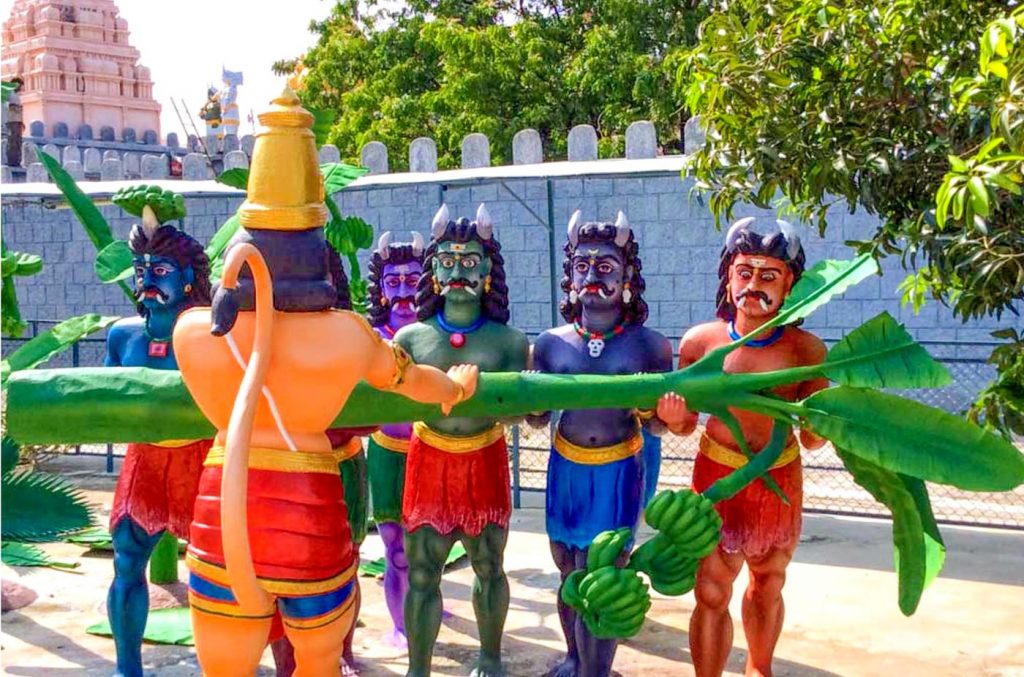
A whole day can be spent exploring the museum walkways, which are nearly two miles long. You can combine a trip to Surendrapuri with the nearby Sri Lakshminarasimha Swamy Temple at Yadagirigutta. Yadagiri has the closest hotels and food. The best way to reach the museum is via road from Hyderabad. Website—surendrapuri.com/
Kala Bhoomi Crafts Museum, Odisha
Kala Bhoomi, in the temple city of Bhubaneswar, is young, opening just in 2018. It was created as a lively space where visitors can interact with the arts and artists. The pleasantly designed 13-acre site oozes the essence of Odisha culture. The gardens are well maintained, the walls are covered with tribal art and the courtyards have an open-air display of tribal life and temple architecture.
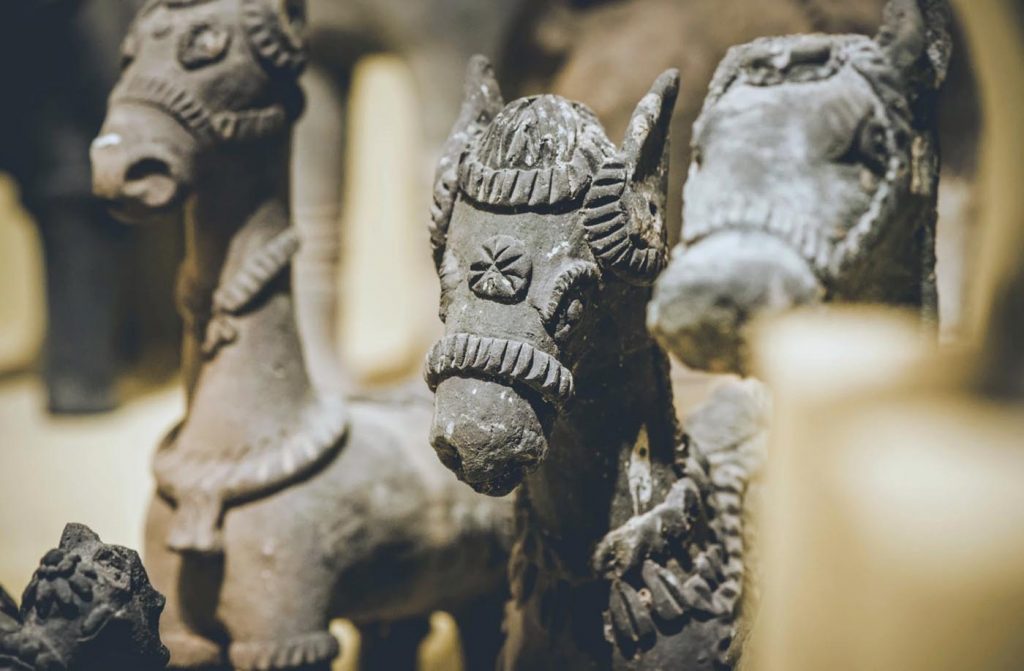
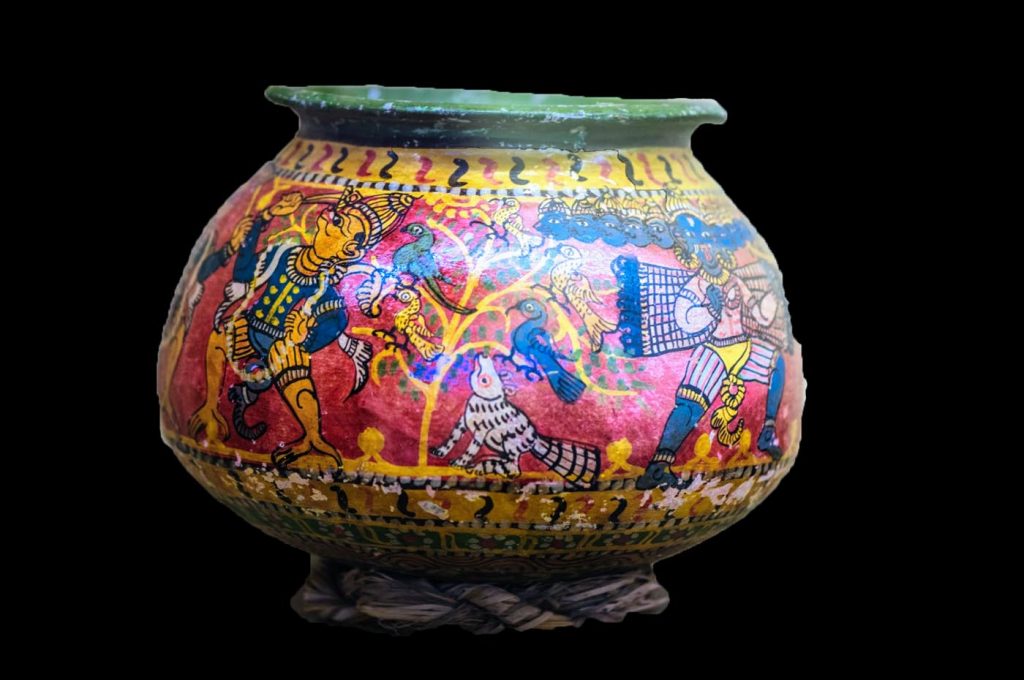
Kala Bhoomi’s eight galleries showcase terracotta, paintings, stone carving, wood carving, metal crafts, tribal crafts and hand looms. The art of stone carving is still practiced in Odisha, and the state has many workshops. Most hotels and public spaces have stone sculptures in their decor. For the finest examples, you must see the stone gallery where the master craftsmen have chiseled the classic emotions. Wood carving, too, is still practiced, and is exemplified in the wooden murtis of Jagannath, Subhadra and Balbhadra at Puri.
A big attraction of this museum is its delicate silver filigree. Cuttack, near Bhubaneswar and the erstwhile capital, is well known for this magical work. The museum also contains larger artifacts, such as sailboats that remind us of the maritime history on India’s east coast. There are, of course, Deities and many decorative items.

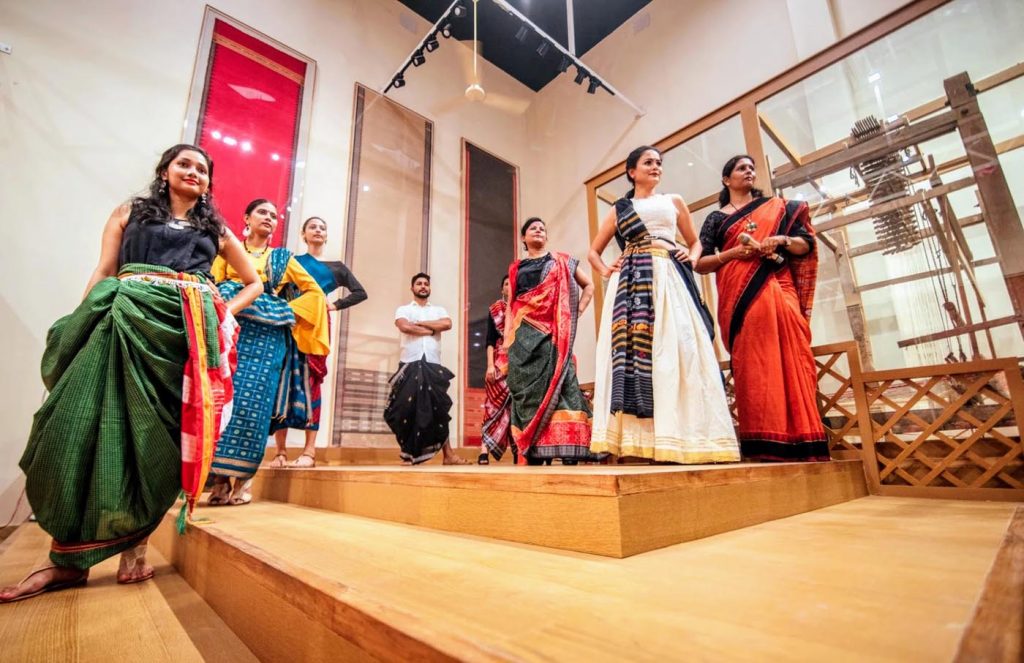
The art of this state is not to be missed. Another standout gallery is Farm Craft, where the products are made from bamboo, grass, palm leaves and more. Odisha’s famous palm-leaf paintings, made by piercing the surface of a leaf and filling it with black color, tell stories from Indian history in a nutshell. Also on display are fine paintings on terra-cotta pots, coconut shells or areca nuts, available for purchase as souvenirs. When I visited, artisans were making beautiful artifacts and jewelry using rice grains and cotton thread. It is one thing to see a finished piece. Watching it being made helps you appreciate the skill and effort involved.
Odisha’s rich handloom heritage is proudly displayed with Sambalpuri Ikkat, Ganjams Bomkai and tribal Kotpad saris. There is a silk trail showcasing the indigenous varieties like Tussar and Eri. You can buy much of what you see at the museum’s well-curated shop.
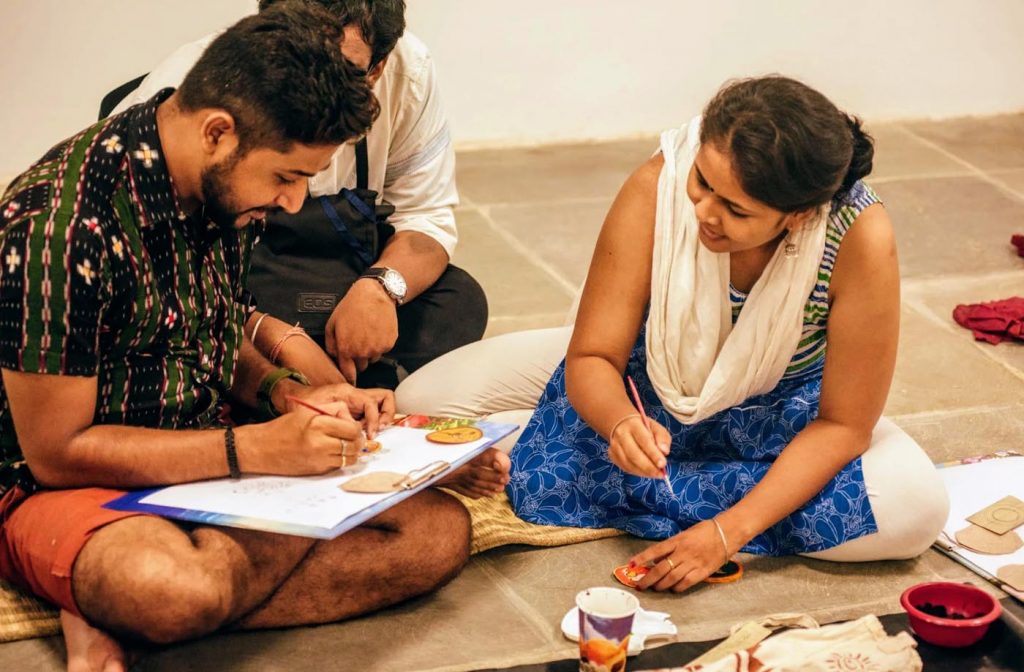
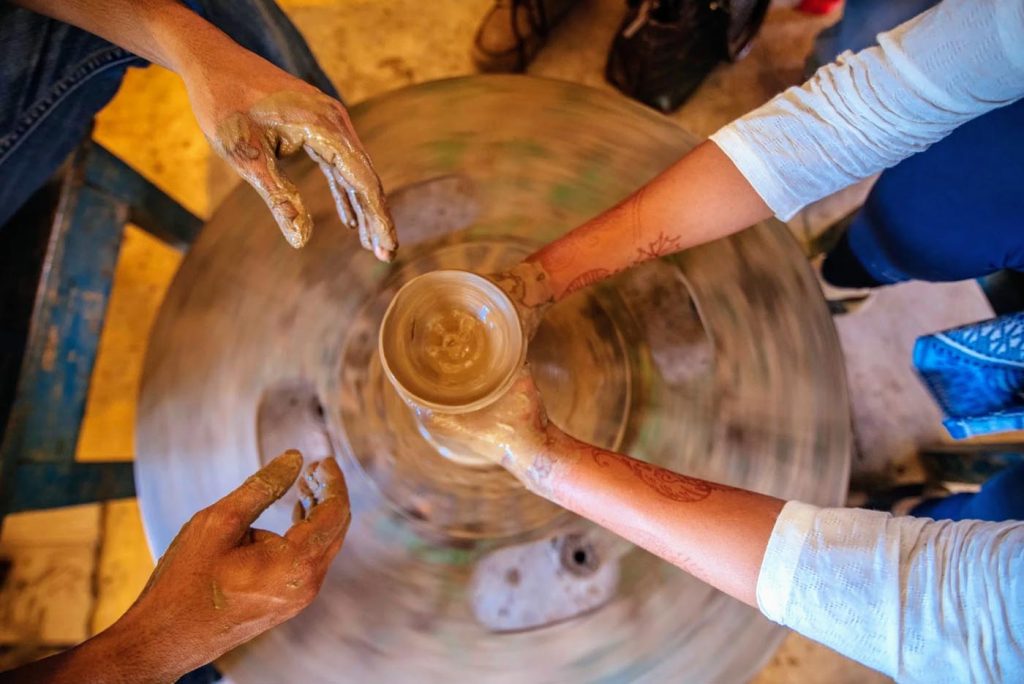
The museum is easily accessible from Bhubaneswar. For a nominal fee you can take a guided tour or a museum walk on specialized trails, available from time to time. Photography is allowed, but no tripods. You can combine this with a visit to nearby Udayagiri and Khandagiri Caves. Website—odishacraftsmuseum.com/
Bhau Daji Lad Museum, Mumbai
Mumbai is very cosmopolitan. People from around the world and India have settled here to do business, making it their home and adding to the fabric of the city. The ethnic diversity of the city can be savored at this museum. First opened in 1857, this oldest museum in the city was named Victoria and Albert Museum, but in 1975 it was renamed after a key patron—Dr. Bhau Daji Lad, Mumbai’s first Indian sheriff. The pistachio-green building documents the “city of seven islands” through specially created dolls representing every possible community and profession in Mumbai’s tapestry, from bangle sellers on the streets to ship builders. Mumbai is, after all, a business city, the commercial capital of the country.
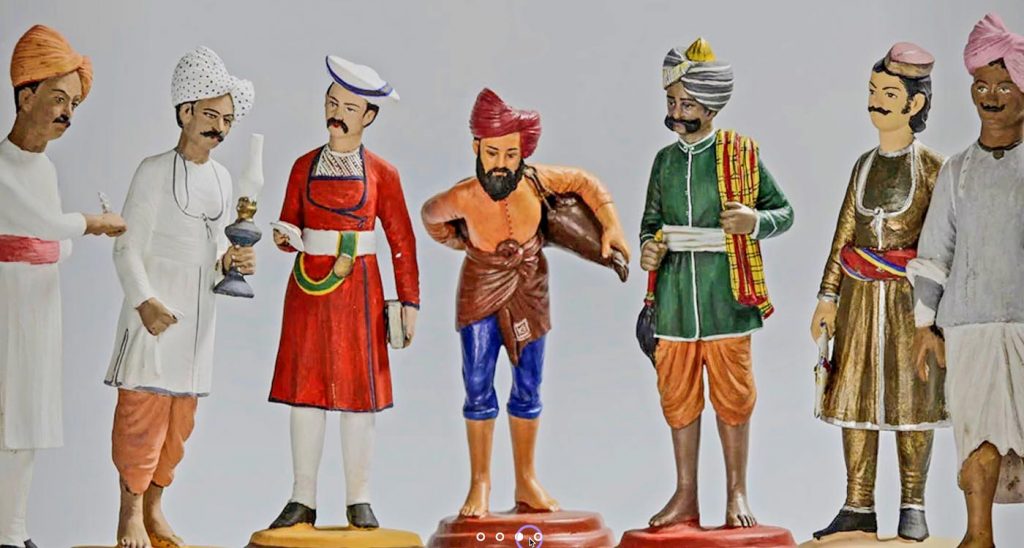


Outside you can see the elephant from Elephanta Caves, and pieces from Mumbai’s old roads. Recently renovated, it has a cafe, souvenir shop and a space to host exhibitions. Website—bdlmuseum.org/
Calico Textiles Museum, Ahmedabad
India is known globally for its exquisite textiles, especially cotton, along with dyeing techniques that introduce vibrancy and variety. Gujarat is one of several textile clusters. At the time of Indian Independence, it was home to many textile mills, one of which was Calico Mills, owned by the Sarabhai family. In 1949 (just after independence), at the urging of art historian and philosopher Ananda Coomaraswamy, this family established the Calico Museum to showcase ancient garments that featured India’s distinct weaves and patterns. The museum was inaugurated by Jawaharlar Nehru, the first prime minister of India.

Now the museum is housed in a heritage haveli of the family, adding an aura of the past. The haveli is divided into two zones. One houses textiles used for religious purposes, as well as a collection of Chola bronzes and Jain art, including manuscripts and miniature paintings. The second zone, called Chauk, displays collections from royal art, including tents, carpets, costumes and furnishings.
Gujarat remains a business bastion of India, and the Calico Museum captures the history of textile trade in the nation through the displays of traded items. A wide range of embroidery embellishing these textiles is also on display. Unlike a typical museum, you interact directly with the displays, though you cannot touch them, as that would damage the fragile cloths. The publications division contains books on textiles and reproductions of masterpieces depicting yantras or religious art used for worship, available as posters as well as on fabric. These are hard to find elsewhere.
This is not an easy place to visit. You need to pre-book the guided tour, arrive within the specified 15-minute window and then follow the guide, who is not obliged to be friendly. There is no climate control, so it can get stuffy. Only about 20 people are allowed daily, so plan ahead. No bags, phones or photography is permitted. Website—calicomuseum.org/
India’s textiles are also on view at the well-curated Sanskriti Anandgram Museum in New Delhi—and at a crafts museum in Varanasi that displays the famous Varanasi silks which have been traded from the city since time immemorial.
Uruswati Folklore Museum, Haryana
This museum spotlights people’s everyday lives, reflected in the spaces we live in, stories we pass through generations, the patterns we weave on our textiles, our items of everyday use, as well as our music and our folk dances that are not performances but a collective expression of shared emotions.
Located just off the highway connecting Delhi and Jaipur, this is technically in Sector 78 of Gurugram in the national capital region. Immediately noticeable here are the large terracotta tablets telling folk tales of the region, including stories of Krishna, kings and love stories. Two tree-lined walkways named Thandi Sadak, “cool road,” and Gul Gulfam resemble distant Kashmir, where similar silver oak trees line the roads.
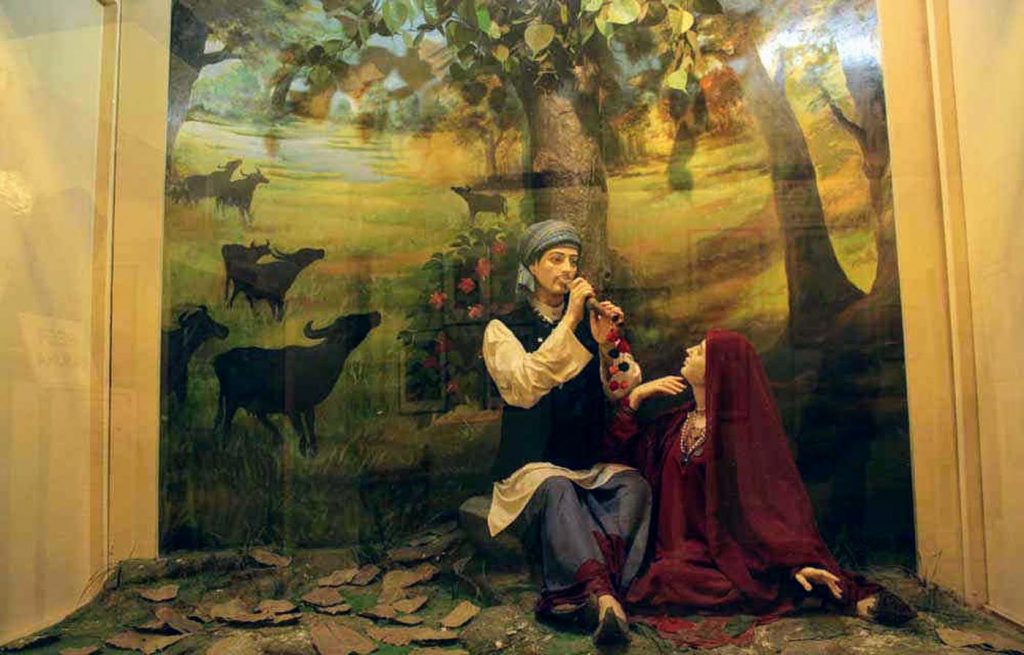
The museum’s two floors showcase paintings, embroidery, jewelry and household items seldom used now, like perfume boxes or churning pots. All these items evoke the culture which produced them. I especially recommend the museum’s murtis and temples of local Deities, usually made in wood, each with a story to tell. Sanjhi is a form of Devi worshiped in parts of North India during Navaratri that is hardly known outside the families who practice it. When I saw a Sanjhi image made traditionally, using cow dung and clay on the walls of this museum, it was sheer nostalgia. The seed to write about it was born inside me, finally taking shape in the form of a book called Navaratri—When Devi Comes Home.
Fairs are an integral part of folk life, bringing people together for festivities and trade. The museum presents a unique documentation of these socio-cultural events that followed their own calendar. It also organizes cultural events with folk performances from around the region.
The souvenir shop is not to be missed. I picked up a copy of Love Legends of Haryana, an illustrated book published by the museum. There are oral stories of the saints and sages who wandered through these lands. Most remarkable is Uruswati’s handwritten documentation in calligraphy. It adds a personal touch and also keeps alive the art of calligraphy in a useful way. Website—urusvatiart.com/folk-lore-museum
Bharat Kala Bhavan, Varanasi
Varanasi city is an educational hub and India’s spiritual nerve center. So, no wonder that one of the country’s earliest museums was conceived here in 1920, as part of Bharat Kala Parishad. After moving to various locations, it finally settled in a lovely building on the campus of Banaras Hindu University (BHU). Its Mahamana Gallery is dedicated to Pandit Madan Mohan Malviya, the university founder, highlighting his life and times—an introduction to this great personality who designed the campus using the principles of Vastu.
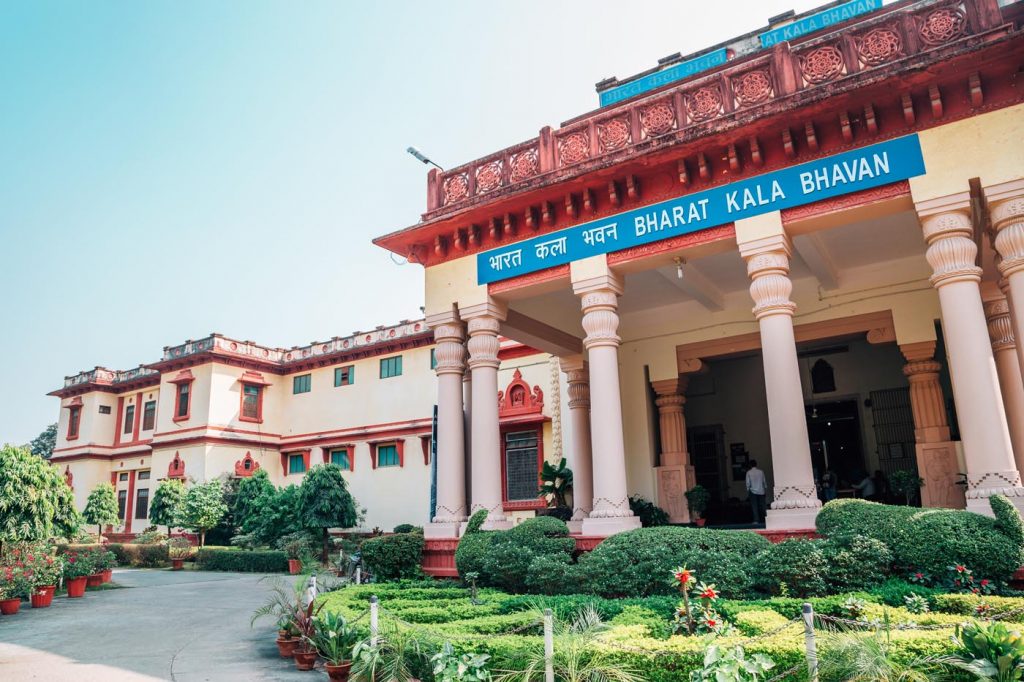

You will see many letters and notes hand-written by various Indian leaders during the independence struggle. Newspapers and periodicals from the early 1900s here are a delight to read, as is local literature by the likes of Munshi Prem Chand and Jayasi.
Varanasi is celebrated through a display of masks used in the famous month-long Ram Leela of Ramnagar. Maps, artifacts and archival material take you through the city’s historical dating back to the Satyuga, when Raja Harishchandra visited from Ayodhya. Here Buddha gave his first sermon and Jain Tirthankars were born. Poet saints like weaver Kabir lived here. All these wonders are honored in the gallery.
With Varanasi being one of India’s biggest weaving hubs in India, a textile room here introduces cotton, silk, wool and blends of these, with myriad expressions using different weaves and patterns. A decorative art room is full of medieval collections. A sculpture gallery brings you some of the finest from the Ganga-Yamuna plains. Most of these are carved using Chunar stone found near Varanasi. This stone was used by the Sarnath School of Sculpture, and the famous Ashoka pillars were carved from it.
Most memorable to me is a precious collection in a vault which opens only for a short period. It has vintage jewelry with miniature paintings, jade bowls, studded gold jewelry, coins and musical instruments in silver. The museum also has great books on art.
You can easily spend half a day here. Nearby you can visit the New Kashi Vishwanath temple in the BHU campus that has the tallest shikhara, tower, of all the temples in India. Take a walk around the campus in the evening to admire the architecture, which combines many styles in quintessential red and yellow color. Website—bhu.ac.in/kala/
Napier Museum, Kerala
Napier Museum, in the heart of Thiruvananthapuram city, stands out in my mind for its absolutely unique architecture. Named after the then governor general of Madras, as the region was called, this masterpiece was designed for Ayilyam Thirunal Maharaja by Robert Chisholm as a museum. The ornate outer walls display a mosaic of red, pink and blue tiles, punctuated with the typical dark wooden windows and doors of this region. The steep conical roofs on top never let you forget you are in Kerala, even though the architecture has influences from Europe, China and North India, making it a one of its kind Indo-Saracenic architecture in the region with Gothic roofs and minarets. A remarkable thing about this museum is its natural air-conditioning system.
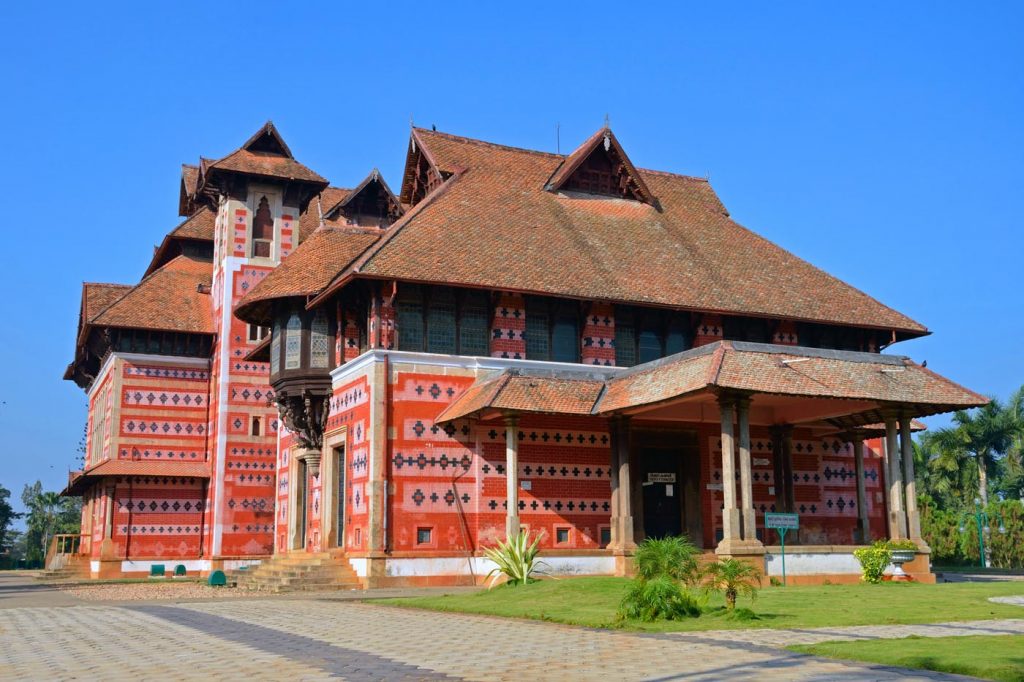
Inside it is a typical museum, with sculptures in bronze and stone, paintings, wood and ivory carvings, lamps, textiles, traditional musical instruments, and numismatic collections. Notable here is a temple chariot. The museum has a bandstand with concealed speakers where the Travancore army band used to play. No photography is allowed inside.
Napier Museum is a part of a complex that also houses one of the oldest zoos in Asia, a natural history museum and the Sri Chitra Art Gallery. Napier Museum and this art gallery (along with Lakshmi Vilas Palace, up north in Vadodara) are the best places to see the original work of Raja Ravi Varma, one of the most celebrated painters of modern India.
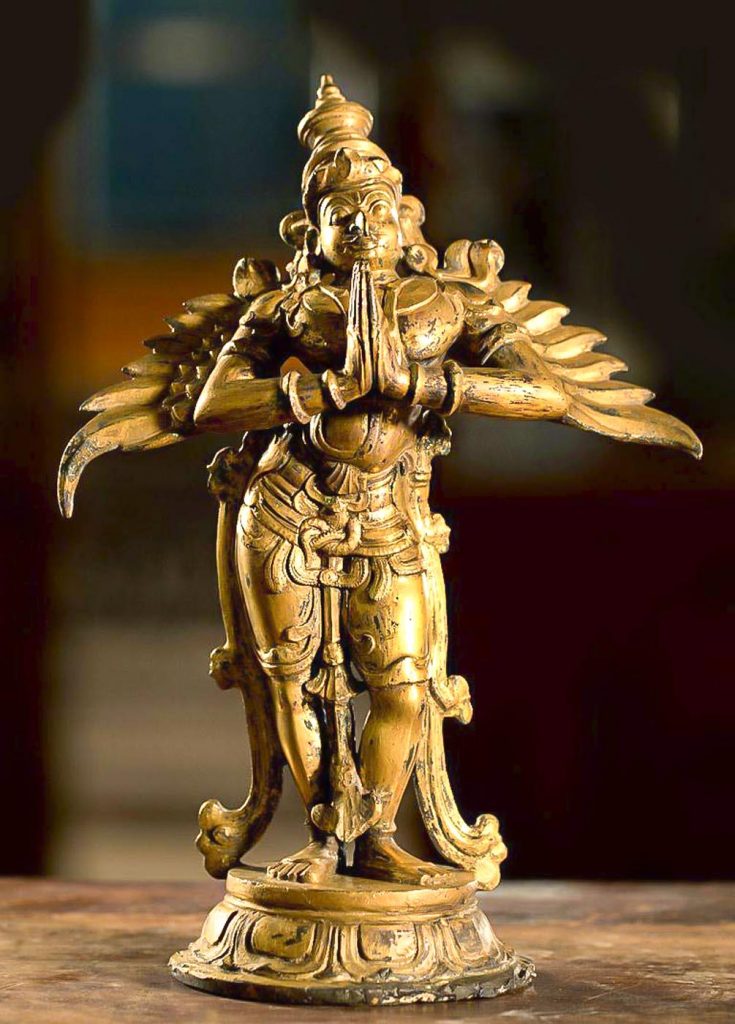
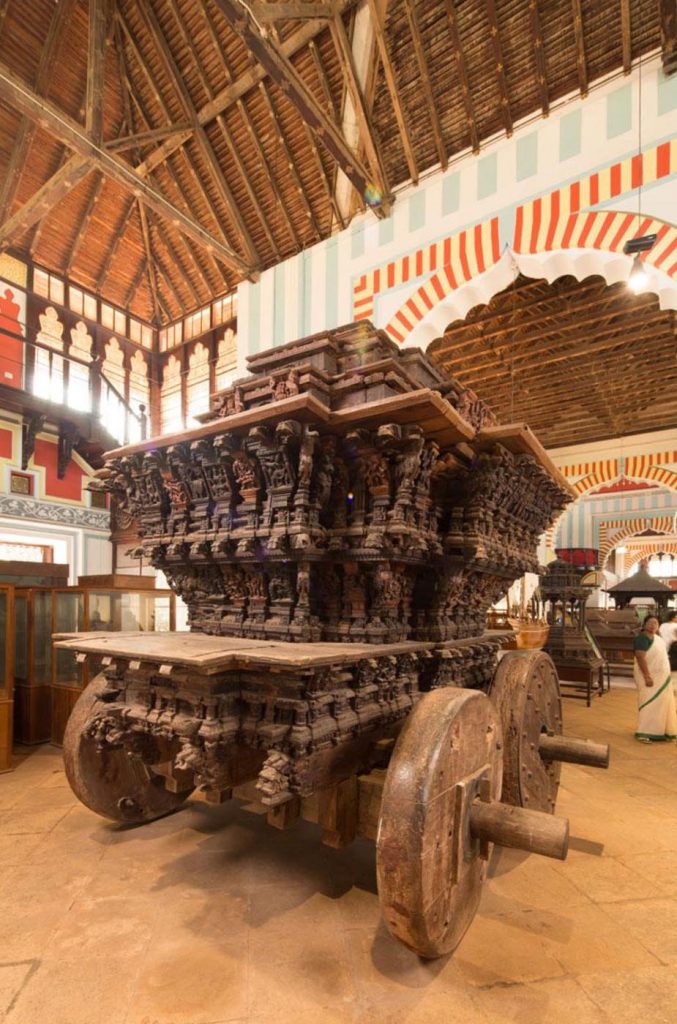
Varma revolutionized the art by bringing in lithography, which made the prints of his paintings present in every Indian household and a part of calendar art. He came from the royal family of Travancore, but his art flourished under the patronage of Gaikwads, the royal family of Baroda, while he was based in Mumbai. His famous paintings of Shakuntala and Damayanti can be seen here.
Works of other celebrated painters like Tagore, Jamini Roy and Nicholas Roerich are also displayed, along with traditional miniature paintings from across the country. There are reproductions of the murals of Ajanta Caves in Maharashtra and Sigiriya in Sri Lanka. An Oriental collection showcases paintings from China, Japan, Tibet and Bali, creating a melange of Eastern cultures. Website—napiermuseum.org/
Thanjavur Palace, Tamil Nadu
This beautiful Maratha palace in Thanjavur, called Aranmanai by the locals, was originally named Shivgangai Fort by its builders, the Thanjavur Nayakas, who ruled from here after the fall of Cholas and Pandyas. The area was later ruled by Marathas till the British took over, but the palace itself always stayed with the royal family. Today it is a museum, visited by tourists and history enthusiasts. Attractions include the colorful Durbar Hall, Saraswati Mahal Library, the bell tower and the Raja Chola Art Gallery. The complex is a mish-mash of buildings in different styles, with pathways connecting them.
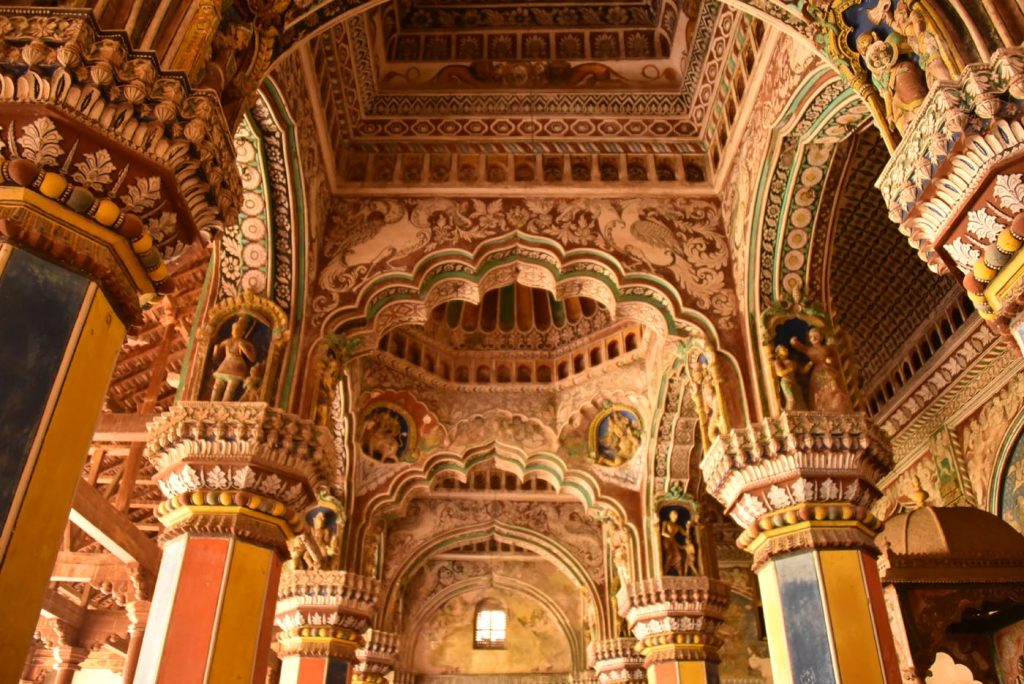
The bell tower, seven stories tall, served as a watchtower and also for darshan of Brihadeeshwara temple and the Ranganatha temple in Srirangam. It was probably much taller than what we see today. It reminded me of the beautiful deepstambhas that we see in temples of Maharashtra. Locally it’s called Maadamaaligai, referring to its square structure. At one time, it had a bell that was rung at regular intervals to announce the time.
This palace museum has royal artifacts like headgear, weapons and sculptures. Serfoji Memorial Hall, originally the living quarters of the royal family, now commemorates their life through displays and photographs.
The museum’s highlight is the colorful, opulent and ornate Durbar Hall, which makes your eyes struggle to choose a focus. There are scenes from epics, portraits of rulers and various Deities painted in bright colors. A life-size statue of Maharaja Serfoji stands in the middle.
Raja Chola Art gallery has some beautiful Chola bronzes, special in that you see them in situ, in the Chola heartland where they belong. On the upper floor is a 90+ foot skeleton of a whale that was found on a beach in 1955, and an inverted lotus-shaped ceiling.
Saraswati Mahal Library has an amazing collection of palm-leaf manuscripts in Sanskrit, Tamil and other languages. I was fascinated by the detailed manuals describing species of elephants and horses, generously illustrated with drawings and sketches. Many of these books were published by the Serfoji press, telling us about the recent publishing history of the city.
Once you are in Thanjavur, the museum is not difficult to locate. When visiting, you have to buy a separate ticket to visit each area.
Conclusion
Here I have offered a glimpse of what you will find in some of the museums in India. Each is a window that lets you peek into the past to explore the culture, diversity, traditions and peoples of ancient and modern Bharat.
About the Author
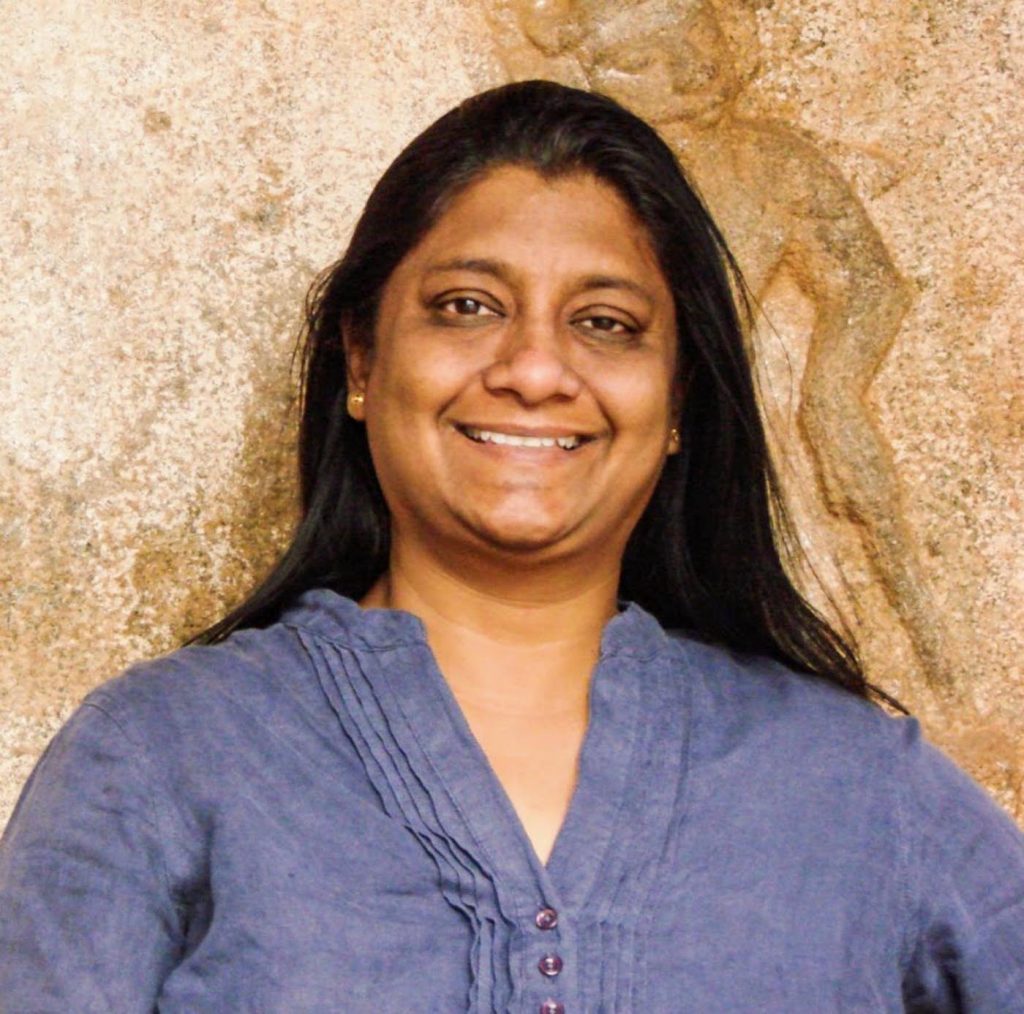
Anuradha Goyal is one of India’s leading travel bloggers. Her focus at www.IndiTales.com is ancient India and temple architecture along with old techniques such as water management with step wells.
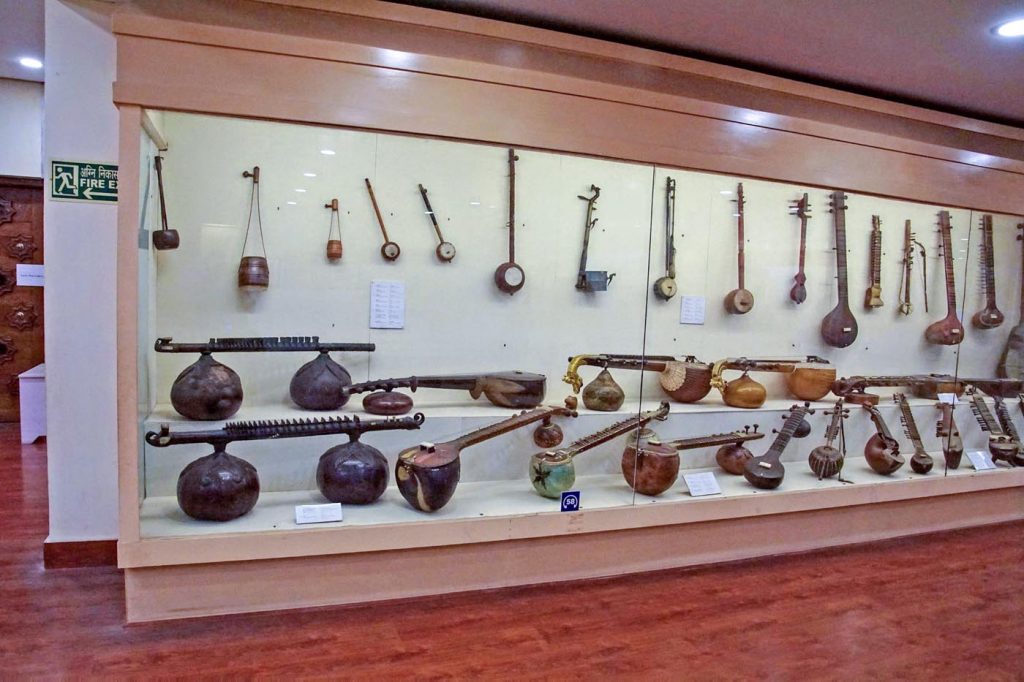
I am soooooo happy to have found you!
I loved every bit of what you have written in these pages;
Reminder of a very glorious time that made the whole world want US,
When I travelled for lectures to students, I saw a lot of BhArat MAtA.
I remember being in the Sarasvati Mahal —— then only a beginning of a museum, with hardly any written explanation of the Murtis and the irrepressible art of our nation!
I am so grateful to read all your explanations. Kindly be in touch with me —- I would very much like to produce a book of Art from BhArat. I have lived in the USA for neatly 56 years, I was 21 when I landed here in the month of January with a 7 weeks old baby girl —— that too to mid- western USA and I survived all these years, even thrived with my saint of a husband !
I set up a family foundation in 1995 named SeedTheWorld.Org that has worked in BhArat and allowed me to read and see many wonderful parts of my land of birth.
But all that I will tell you when you do contact me……….. very soon I hope👌👍
No mention of Raja Dinkar Kelkar museum in Pune, Maharashtra of many cultural artifacts not mentioned above.
Hello, I’m interested in Vedic history, guijarti heritage tours, history of the india valley civilizations, museum of Hinduism, yoga, Vedic philiosophy, upinishads. Etc. do you know where I can learn the most of about this?
Nitesh